Menus
- BMW HP4 in the top test
- MOTORCYCLE points evaluation / conclusion
- HP4 against S 1000 RR
- Technical data / mode settings
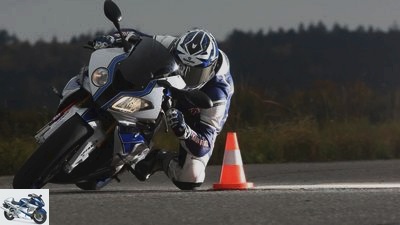
Jahn
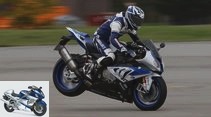
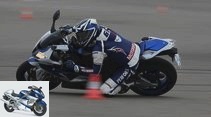
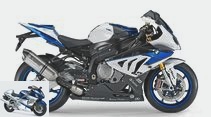

13 photos
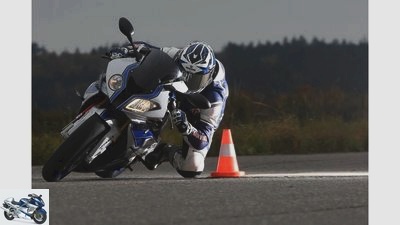
Jahn
1/13
The BMW HP4 in the top test. The world’s best road-legal super sports bike tested by MOTORRAD.

Jahn
2/13
At the limit: The active chassis of the HP4 is designed for such situations – and it does what it promises.

Jahn
3/13
A real performer: the HP4 flying low on the circular path.

Jahn
4/13
The HP4 in competition look, with blue rims, lots of carbon, Gilles notches and hand levers.

Jahn
5/13
BMW Motorrad Dynamic Damping Control (DDC).

Jahn
6/13
Inconspicuous but effective: the DDC is located in the left fork leg.

Jahn
7/13
MOTORRAD-Messtechnik II: the kickback track and an imperturbable test driver.
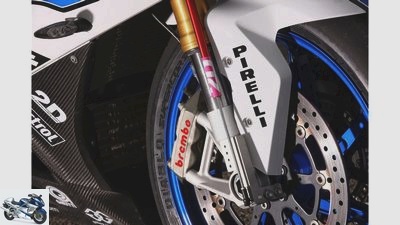
Jahn
8/13
MOTORRAD measurement technology I: suspension travel sensor on the fork, new brake system.

Jahn
9/13
MOTORRAD measurement technology I: suspension travel sensor on the fork, new brake system.
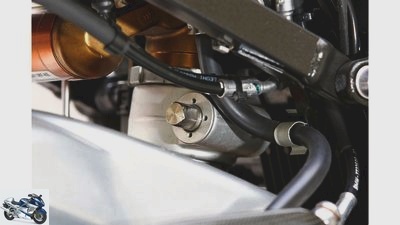
Jahn
10/13
BMW measurement technology (rear suspension travel sensor) including potentiometer.
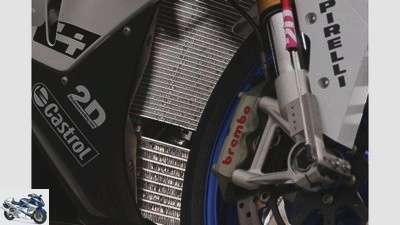
Jahn
11/13
Not so nice: unprotected cooler with impact marks.

Jahn
12/13
Another button: the right rocker switch adjusts the DTC.
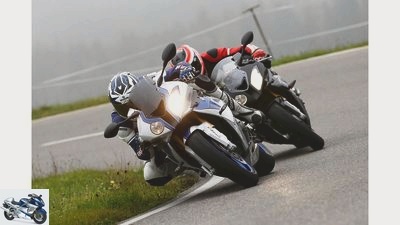
Jahn
13/13
The original target for the HP4 was clearly defined. It should satisfy the experts on the racetrack, less the normal S 1000 RR customers. The fact that both were successful is mainly thanks to the new chassis technology.
The further development of the BMW S 1000 RR
BMW HP4 in the top test
They know their way around the inviolable in the Free State. The emperor, the kini, even the pope – all Bavaria. Now they want to put the crown on the sports motorcycle. The HP4 competes to outshine everyone.
There is dynamism in the BMW operation. And even room for a little casualness. Albert Wagner, mastermind behind BMW traction control, allows his Weber B-fractured ankle to rest on a chair. Dr. Uwe Schatzberger, Project Manager Dynamic Damping Control, is actually already on vacation and still has a quick look. And Rudi Schneider, Project Manager HP4, brought his baby with him because he hardly ever gets off. Plaster of paris and leather instead of tie and collar, assembly hall instead of conference room – these guys are really into it.
HP4 is the name of the latest coup from Bavaria, and its semi-active DDC chassis is the next thorn in the competition after the powerful inline four-cylinder and all-round carefree assistance systems ABS and DTC (Dynamic Traction Control). A chassis that has everything in its program, from cuddly soft to board-hard, that is the promise. But how does that work?
Buy complete article
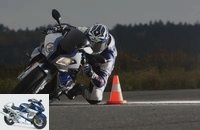
The further development of the BMW S 1000 RR
BMW HP4 in the top test
HP4 puts the usual MOTORRAD test procedure. What can you measure, how can you represent it, what do you have to pay attention to? “Try it out, just try it out!” The three experts laugh. Because even if this system was developed primarily for the fast lap on the racetrack, it is mainly the bad stretches on which the advantages become obvious in everyday life. “The comfort on the country road was a pleasant side effect. But of course that is not to be despised either. ”
Change of scene: the brutal MOTORRAD kickback test track, a cloudy autumn day. The rich (but by no means loud) sound of the standard Akrapovic complete system made of titanium fill meadows and forests, announces the HP4 before it can be seen. Second, third, fourth gear, the row four screeches in the highest tones – then the white and blue Bayern courier flies past. With incredible speed. A super sports car has never been faster here, and the S 1000 RR, which is also on board for comparison, has to give up its sails 15 km / h earlier. Why? Because the handlebars twitch so nervously at this speed despite the steering damper that even hardened testers get queasy. The HP4 fork, on the other hand, “floats” over this beet field in sport mode, confidently cushions both large and fine distortions, and remains stable on course. This is amazing – especially because the -semiive chassis from Munich, unlike the Ducati system of the new Multistrada, does not have a travel sensor on the front wheel.
Jahn
A real performer: the HP4 flying low on the circular path.
“We don’t need the front wheel sensor for the driving situations to which we wanted to react,” the trio explained in Munich. Heavy braking maneuvers, full acceleration phases, rapid bank changes in chicanes – these typical race track situations were in the specifications, not the curb or the pothole. If you want to understand why the DDC still works so well here, you have to deal with the basic functionality. With the four driving modes (Rain, Sport, Race, Slick), with three resulting basic settings for the chassis (Rain and Sport have an identical set-up). And above all with the fact that the three settings do not mark a fixed characteristic curve as with conventional ESA, but a wide setting range. In this setting range, the damper valves react to the incoming parameters within hundredths of a second. In the specific case, it looks like this – very roughly, because the Munich-based company does not want to look too deeply into the cards – wide open throttle valves and rapidly increasing speed signal the need for increasing damping on the rear wheel, the damper valve closes – of course also in Dependence on the rear spring deflection sensor – within the defined setting range. At the front, however, precisely those parameters – namely the rapid increase in speed, the wide open throttle valve and the increasing speed – allow the damper valve to open to the lower edge of the setting range even without a spring travel sensor, because the front wheel is largely relieved in this situation. With the described comfortable consequences on the HP4 front, while the shock absorber in the stressful situation is tighter, but also not rock hard.
For an athlete with such ambitions, the new HP4 offers astonishing comfort. And with the “Sport” setting (as usual, in an exemplary manner, easy to select from the right handlebar end), the right setting for all imaginable everyday situations. The chassis as comfortable as possible, the traction control regulating early (but not too early), the ABS with absolute braking stability and yet sufficiently short braking distance. Protected in this way, it is not only fun to accelerate properly on smooth terrain (then the assistance systems usually have a break anyway), but also when things get a little dubious. And even when it rains, because the rain mode adjusts ABS and DTC even more sensitively and moderates the increase in torque of the engine in a linear manner, but has recently no longer cut off peak performance.
Jahn
At the limit: The active chassis of the HP4 is designed for such situations – and it does what it promises.
Nominally 193 HP, measured 200 HP – in this respect not much has changed during the metamorphosis from the S 1000 RR to the HP4. The power and torque curves, on the other hand, show more pressure in the medium speed range, as promised. “Mapping and exhaust system” is the succinct saying in Munich.
In practice, this marginal advantage on the test bench diagram means a significant performance boost exactly where it applies on the home route, namely between 4000 rpm and 8000 rpm. In this area, the HP4 makes its civilian sister look mighty old, which is reflected not only in the pure pulling power, but also in the impressive test course times. Regardless of whether it is faster or slower slalom, whether it is a circular path or brake measurement: the HP4 performs even better than the already very good S 1000 RR, which is always included for comparison.
Jahn
MOTORRAD measurement technology: the kickback track and an imperturbable test driver.
This lead would not be possible without the new suspension technology, which is convincing on the course even in sport mode – but far more so in race or slick mode with the corresponding, significantly tighter set-up. It would certainly not be possible without the conventional means with which BMW increased performance. Noticeably lower total weight (from 209 to 203 kilograms), light forged wheels, Brembos monoblock instead of two-part brake calipers, newly adapted pads – you can feel that not only on the course, but happily also in everyday life. The HP4 is easier to throw from one corner to the other, follows the steering commands even more precisely (which Pirelli’s Supercorsa SP instead of the Metzeler Racetec K3 on the S 1000 RR play their part) and brakes not harder, but noticeably more controllable.
So all in all an absolutely convincing package. But also a very expensive one, because the test motorcycle, including the competition package (see data), costs just under 25,000 euros. The basic HP4, on the other hand, at 20,500 euros, is an offer that should also make S 1000 RR interested parties sweat. After all, they not only get the clearly better BMW superbike for this, but also the first to master the previously impossible balancing act between country road and race track so brilliantly. And so it should remain inviolable in this segment until further notice.
MOTORCYCLE points evaluation / conclusion
Jahn
The HP4 in competition look, with blue rims, lots of carbon, Gilles notches and hand levers.
engine
The only weakness eradicated: Under this heading you have to see the chapter on the engine, because in terms of acceleration and top speed there was nothing to complain about with the S 1000 RR anyway. And so it is the significantly better pulling power that gives the HP4 two points more than the S 1000 RR.
landing gear
The hour of dynamic damping control: Even if the points evaluation cannot show it in this clarity, the chassis of the HP4 represents a huge step forward. The more precise steering behavior and, above all, the successful chassis tuning at the front have to be credited to the DDC, as is the comfort of the suspension. The increased handiness, however, is due to the overall lower weight and the light wheels.
everyday life
The HP4 and the chapter on everyday life: this is by no means mutually exclusive, on the contrary, it forms a convincing symbiosis. The equipment is just as impressive as the workmanship and high-quality components; the lower weight, together with the slightly increased gross vehicle weight, results in a higher payload.
security
It’s just one more point, but the noticeably better controllability of the new braking system with Brembo monoblock calipers and newly tuned pads is also a real asset in everyday life. And a pleasure to boot.
costs
Nothing happened here: Anyone who wants to ride a super sports bike like the HP4 or S 1000 RR has to dig deep into their pockets.
Price-performance
The impression is a little deceptive. The only reason why the HP4 falls so significantly behind in terms of price / performance rating is because it carries the expensive competition package (3200 euros).
| Max points | HP4 | S 1000 RR | Overall rating | 1000 | 730 | 713 |
| Price-performance note | 1.0 | 4.0 | 2.7 |
Conclusion
It’s not quite squaring the circle. Nearly! Every bet: Anyone who gets on the new HP4 as an enthusiastic sports driver will get off again in euphoria. Because this motorcycle has everything you could want on it. She shakes the comedy country road tour just as easily out of her sleeve as a peak time in the top test course. And on the racetrack, all it takes is the push of a button and she becomes a racing queen. Guaranteed!
HP4 against S 1000 RR
Jahn
The original target for the HP4 was clearly defined. It should satisfy the experts on the racetrack, less the normal S 1000 RR customers. The fact that both were successful is mainly thanks to the new chassis technology.
The lead that the HP4 can gain over its civilian sister is a solid 17 points (see points evaluation). This is an enormous cushion for super athletes. And almost unbelievable in view of the radical orientation with which the Bavarian noble athlete comes along.
The old formula “torture chair in everyday life, fast on the racetrack” from the blessed Ducati days has finally had its day. On the contrary: their makers ascribe IDM suitability to the HP4 without modifications (more on this in the next issue in the extensive racetrack test). And MOTORRAD high suitability for everyday use. An example: The HP4 pulls through noticeably better than its standard sister (two points more!) Without losing just a touch of top performance. It is more manageable (without sacrificing stability), steers more precisely, and brakes more precisely controllable. And in all of this it is even more comfortable than the S 1000 RR, which also allows different riding modes to be selected, but which have no effect on the chassis.
So new electronics times have dawned, which are also reflected in other features of the HP4. For example in the Launch Control, which can be activated at the push of a button and regulates the speed / torque during rocket launch so that even amateurs accelerate just as quickly as the MOTORRAD tester. However, there are no points for this in the MOTORRAD scoring. Otherwise the lead would be even greater.
archive
Damping force over damper speed.
No characteristics, but broad characteristics – that is the advantage of the semi-active HP4 chassis. According to the preselected mode, the damping of the rebound stage (above) as well as the compression stage (below) varies actively within these fields.
archive
Suspension strut movement (faster slalom).
Fast change of lean angle on the top test course: In sport mode, the HP4 compresses further and more violently than in radical slick mode. And is measurably slower.
archive
Spring movement fork (kickback section).
This is what comfort looks like: On the kickback route, the HP4 compresses significantly deeper in sport mode – and thus absorbs hard hits much better than in slick mode.
Technical data / mode settings
archive
The performance diagram of the BMW HP4 and S 1000 RR.
engine
Water-cooled four-cylinder four-stroke in-line engine, two overhead, chain-driven camshafts, four valves per cylinder, rocker arm, wet sump lubrication, injection, Ø 48 mm, regulated catalytic converter, 350 W alternator, 12 V / 7 Ah battery, mechanically operated multi-disc oil bath clutch (anti- Hopping), six-speed gearbox, chain, secondary ratio 45:17.
Bore x stroke 80.0 x 49.7 mm
Displacement 999 cm³
Compression ratio 13.0: 1
rated capacity 142.0 kW (193 hp) at 13,000 rpm
Max. Torque 112 Nm at 9750 rpm
landing gear
Bridge frame made of aluminum, upside-down fork, Ø 46 mm, adjustable spring base, electronically adjustable rebound and compression damping (DDC), steering damper, two-arm swing arm made of aluminum, central spring strut with lever system, adjustable spring base, electronically adjustable rebound and compression damping (DDC), Double disc brake at the front, Ø 320 mm, four-piston fixed calipers, disc brake at the rear, Ø 220 mm, single-piston floating caliper, semi-internal brake system, ABS, traction control.
Forged aluminum wheels 3.50 x 17; 6.00 x 17
Tires 120/70 ZR 17; 200/55 ZR 17
Tires in the test Pirelli Supercorsa SP, front “C”
Dimensions + weights
Wheelbase 1423 mm, steering head angle 66.0 degrees, caster 99 mm, spring travel f / h 120/130 mm, permissible total weight 408 kg, tank capacity / reserve 17.5 / 4.0 liters.
Service data
Service intervals 10000 km
Oil and filter change every 10,000 km 3.9 l
Engine oil SAE10W 40
Idle speed 1200 ± 50 / min
Tire pressure solo (with pillion passenger) front / rear 2.5 / 2.9 (2.5 / 2.9) bar
Colors white / blue
Price 20,500 euros
Price test motorcycle * 24,750 euros
Additional costs around 269 euros
Mode settings
| Rain | Sports | Race | Slick | E-gas |
| Power (kW / PS) | 142/193 | 142/193 | 142/193 | 142/193 | Torque curve | linear | maximum | maximum | maximum |
| Race ABS | Race ABS | • | • | • | • (IDM setting) |
| Braking delay | geared towards stability | geared towards stability | geared towards performance | everything that goes | Rear ABS | • | • | • | – |
| Stoppie control | • | • | – | – | Dynamic Traction Control (DTC) |
| Setting options | – | – | – | • * | Wheelie detection | • | • | <25 ° | <30 ° |
| Launch Control | – | – | – | • ** | Dynamic chassis control (DDC) |
| Setting options | • | • | • | • | Suspension adjustment | Road | Road | Dynamic | Track |
* seven levels for more assistance / seven levels for less assistance from the DTC
** Launch Control activated = DTC off; DTC switches on again: from 3rd gear or < 30 ° incline or when braking
Four settings, but many links: BMW focuses on ease of use. There is full power in every mode, including ABS. In slick mode, however, only on the front wheel. Stoppies are only prevented with Rain / Sport, the DTC can be set in Slick mode, the wheelie detection always works with Rain / Sport, with Race / Slick depending on the lean angle. Launch Control only works in slick mode, the DDC is always active.
Related articles
-
Comparative test of athletes: BMW S 1000 RR against Honda Fireblade
13 Bilder Kunstle 1/13 The on-board tool kit of the BMW almost ties in with old traditions. With the help of the nine-piece set you can …
-
BMW HP4 and BMW S 1000 RR in a comparison test
Jahn 37 pictures markus-jahn.com 1/37 The new one: BMW S 1000 RR in profile. markus-jahn.com 2/37 BMW S 1000 RR. markus-jahn.com 3/37 The unearthly: BMW …
-
A comparison of the super sports car BMW S 1000 RR and Ducati 1199 Panigale S
Jahn 16 photos Jahn 1/16 Can the Ducati 1199 Panigale S overthrow the overwhelming BMW S 1000 RR from the throne of superbikes? Does its unconventional,…
-
Driving report Yamaha YZF 600 R and YZF 1000 R
Driving report Yamaha YZF 600 R and YZF 1000 R In rapid succession Yamaha has a big bang this year, bringing two fresh sprinters into play: Thunderace…
-
Honda VTR 1000 test V-Lenz Spring is all about the new two-cylinder. In the spotlight: Honda’s VTR 1000 F. You didn’t like to read it, those responsible…
-
fact Top test Honda Varadero 1000 Pleasure ship Truly a monumental motorcycle, weighing 267 kilograms, as high as a cathedral, comfortable and fast. In…
-
Artist 13 photos Artist 1/13 The on-board tool kit of the BMW almost ties in with old traditions. With the help of the nine-piece set, you can strip the…
-
Technology Kawasaki Z 1000 EFI Archive 1980
archive 17th photos archive 1/17 The control unit tells the system what to do when and with what quantity. archive 2/17 Instruments like on the Mk II;…
-
Suzuki GSX-R 1000 R in the driving report
Suzuki 27 photos Suzuki 1/27 Suzuki GSX-R 1000 R. Suzuki 2/27 Suzuki GSX-R 1000 R. Suzuki 3/27 Suzuki GSX-R 1000 R Suzuki 4/27 Suzuki GSX-R 1000 R….
-
BMW S 1000 XR, Kawasaki ZZR 1400 and KTM 1290 Super Duke GT in the test
Andreas Riedmann 25 pictures andreasriedmann.at 1/25 picture gallery comparison test, power-speed touring bikes: BMW S 1000 XR, Kawasaki ZZR 1400, KTM 1290 …